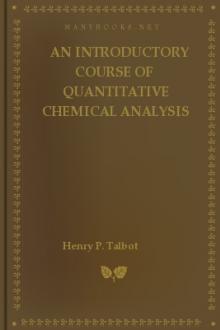An Introductory Course of Quantitative Chemical Analysis by Henry P. Talbot (good short books .TXT) 📖

- Author: Henry P. Talbot
- Performer: -
Book online «An Introductory Course of Quantitative Chemical Analysis by Henry P. Talbot (good short books .TXT) 📖». Author Henry P. Talbot
liter. solution solution
Ammonium oxalate, (NH_{4}){2}C{2}O_{4}.H_{2}O 40 0.5N 0.25
Barium chloride, BaCl_{2}.2H_{2}O 25 0.2N 0.1
Magnesium ammonium chloride (of MgCl_{2}) 71 1.5N 0.75
Mercuric chloride, HgCl_{2} 45 0.33N 0.66
Potassium hydroxide, KOH (sp. gr. 1.27) 480
Potassium thiocyanate, KSCN 5 0.05N 0.55
Silver nitrate, AgNO_{3} 21 0.125N 0.125
Sodium hydroxide, NaOH 100 2.5N 2.5
Sodium carbonate. Na_{2}CO_{3} 159 3N 1.5
Sodium phosphate, Na_{2}HPO_{4}.12H_{2}O 90 0.5N or 0.75N 0.25
Stannous chloride, SnCl_{2}, made by saturating hydrochloric acid (sp. gr. 1.2) with tin, diluting with an equal volume of water, and adding a slight excess of acid from time to time. A strip of metallic tin is kept in the bottle.
A solution of ammonium molybdate is best prepared as follows: Stir 100 grams of molybdic acid (MoO_{3}) into 400 cc. of cold, distilled water. Add 80 cc. of concentrated ammonium hydroxide (sp. gr. 0.90). Filter, and pour the filtrate slowly, with constant stirring, into a mixture of 400 cc. concentrated nitric acid (sp. gr. 1.42) and 600 cc. of water. Add to the mixture about 0.05 gram of microcosmic salt. Filter, after allowing the whole to stand for 24 hours.
The following data regarding the common acids and aqueous ammonia are based upon percentages given in the Standard Tables of the Manufacturing Chemists' Association of the United States [!J.S.C.I.!, 24 (1905), 787-790]. All gravities are taken at 15.5°C. and compared with water at the same temperature.
Aqueous ammonia (sp. gr. 0.96) contains 9.91 per cent NH_{3} by weight, and corresponds to a 5.6 N and 5.6 molal solution.
Aqueous ammonia (sp. gr. 0.90) contains 28.52 per cent NH_{3} by weight, and corresponds to a 5.6 N and 5.6 molal solution.
Hydrochloric acid (sp. gr. 1.12) contains 23.81 per cent HCl by weight, and corresponds to a 7.3 N and 7.3 molal solution.
Hydrochloric acid (sp. gr. 1.20) contains 39.80 per cent HCl by weight, and corresponds to a 13.1 N and 13.1 molal solution.
Nitric acid (sp. gr. 1.20) contains 32.25 per cent HNO_{3} by weight, and corresponds to a 6.1 N and 6.1 molal solution:
Nitric acid (sp. gr. 1.42) contains 69.96 per cent HNO_{3} by weight, and corresponds to a 15.8 N and 15.8 molal solution.
Sulphuric acid (sp. gr. 1.8354) contains 93.19 per cent H_{2}SO_{4} by weight, and corresponds to a 34.8 N or 17.4 molal solution.
Sulphuric acid (sp. gr. 1.18) contains 24.74 per cent H_{2}SO_{4} by weight, and corresponds to a 5.9 N or 2.95 molal solution.
The term !normal! (N), as used above, has the same significance as in volumetric analyses. The molal solution is assumed to contain one molecular weight in grams in a liter of solution.
DENSITIES AND VOLUMES OF WATER AT TEMPERATURES FROM 15-30°C.Temperature Density. Volume.
Centigrade.
4° 1.000000 1.000000 15° 0.999126 1.000874 16° 0.998970 1.001031 17° 0.998801 1.001200 18° 0.998622 1.001380 19° 0.998432 1.001571 20° 0.998230 1.001773 21° 0.998019 1.001985 22° 0.997797 1.002208 23° 0.997565 1.002441 24° 0.997323 1.002685 25° 0.997071 1.002938 26° 0.996810 1.003201 27° 0.996539 1.003473 28° 0.996259 1.003755 29° 0.995971 1.004046 30° 0.995673 1.004346
Authority: Landolt, Börnstein, and Meyerhoffer's !Tabellen!, third edition.
CORRECTIONS FOR CHANGE OF TEMPERATURE OF STANDARD SOLUTIONSThe values below are average values computed from data relating to a considerable number of solutions. They are sufficiently accurate for use in chemical analyses, except in the comparatively few cases where the highest attainable accuracy is demanded in chemical investigations. The expansion coefficients should then be carefully determined for the solutions employed. For a compilation of the existing data, consult Landolt, Börnstein, and Meyerhoffer's !Tabellen!, third edition.
Corrections for 1 cc.
Concentration. of solution between
15° and 35°C.
Normal .00029
0.5 Normal .00025
0.1 Normal or more dilute solutions .00020
The volume of solution used should be multiplied by the values given, and that product multiplied by the number of degrees which the temperature of the solution varies from the standard temperature selected for the laboratory. The total correction thus found is subtracted from the observed burette reading if the temperature is higher than the standard, or added, if it is lower. Corrections are not usually necessary for variations of temperature of 2°C. or less.
INTERNATIONAL ATOMIC WEIGHTS==========================================================
| | |
| 1920 | | 1920
_________________|_________|___________________|__________
| | |
Aluminium Al | 27.1 | Molybdenum Mo | 96.0
Antimony Sb | 120.2 | Neodymium Nd | 144.3
Argon A | 39.9 | Neon Ne | 20.2
Arsenic As | 74.96 | Nickel Ni | 58.68
Barium Ba | 137.37 | Nitrogen N | 14.008
Bismuth Bi | 208.0 | Osmium Os | 190.9
Boron B | 11.0 | Oxygen O | 16.00
Bromine Br | 79.92 | Palladium Pd | 106.7
Cadmium Cd | 112.40 | Phosphorus P | 31.04
Caesium Cs | 132.81 | Platinum Pt | 195.2
Calcium Ca | 40.07 | Potassium K | 39.10
Carbon C | 12.005 | Praseodymium Pr | 140.9
Cerium Ce | 140.25 | Radium Ra | 226.0
Chlorine Cl | 35.46 | Rhodium Rh | 102.9
Chromium Cr | 52.0 | Rubidium Rb | 85.45
Cobalt Co | 58.97 | Ruthenium Ru | 101.7
Columbium Cb | 93.1 | Samarium Sm | 150.4
Copper Cu | 63.57 | Scandium Sc | 44.1
Dysprosium Dy | 162.5 | Selenium Se | 79.2
Erbium Er | 167.7 | Silicon Si | 28.3
Europium Eu | 152.0 | Silver Ag | 107.88
Fluorine Fl | 19.0 | Sodium Na | 23.00
Gadolinium Gd | 157.3





Comments (0)